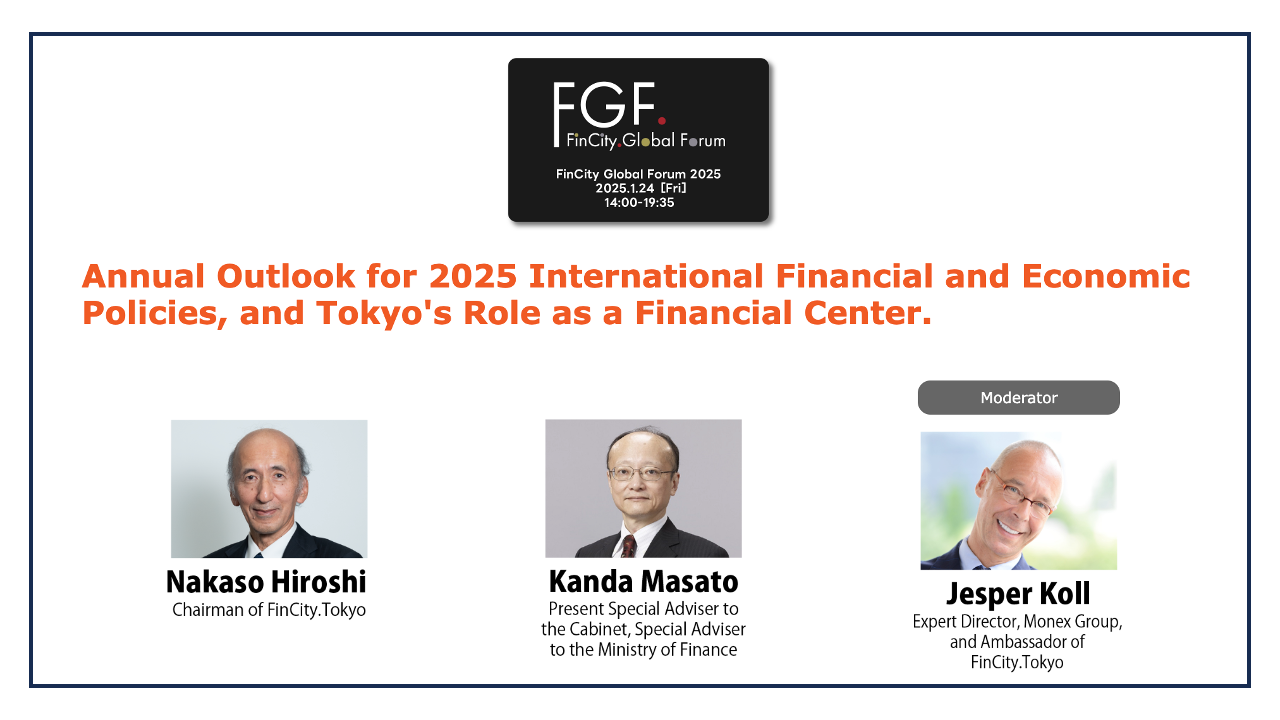2025 Outlook for International Financial & Economic Policies, and Tokyo as a Financial Center

On Friday, January 24, 2024, FinCity.Tokyo hosted the "Tokyo Asset Management Forum" (TAMF) in the morning, and the "FinCity Global Forum" (FCF) in the afternoon.
This FGF Keynote Talk centers around the global economic outlook, with a specific focus on Japan, its economic policies, and its position in the global financial landscape. The conversation was moderated by Jesper Koll, and features two prominent Japanese figures: Hiroshi Nakaso, former Deputy Governor of the Bank of Japan, and Masato Kanda, then Vice Minister of Finance for International Affairs and soon-to-be head of the Asian Development Bank (ADB).
Part 1: Global Economic Outlook and Challenges
Koll begins by acknowledging the Bank of Japan's interest rate hike, announced shortly before this session, setting the stage for a discussion on the global economic picture and specific issues facing Japan. He expresses excitement about the interesting times and welcomes the two "policy superstars."
Nakaso opens by offering a retrospective of 2024, highlighting the fragmented state of the global economy due to persistent geopolitical tensions, particularly the conflict between the United States and China. He notes the dramatic shifts in global trade patterns, with China's direct exports to the US growing moderately while exports to ASEAN economies saw significant growth, suggesting a diversion of trade flows. Similar patterns were observed with China's exports to Mexico and Canada, followed by increased exports from these countries to the US.
Citing the IMF's January World Economic Outlook, Nakaso points out the global economy's growth of 3.2% in 2024 and the projected growth of 3.3% in 2025 and 2026. He emphasizes that these numbers are unimpressive compared to the average growth rate of 3.7% in the past decade. He attributes this slowdown to economic fragmentation and notes the robustness of the US economy, powered by strong consumption, contrasting it with the subdued growth in the Euro area. Nakaso expresses concern about China's economic problems, highlighting the risk of deflation and low inflation rates. He anticipates that the global economy will likely remain fragmented in 2025, with medium-term risks tilted towards the downside.
Nakaso addresses the uncertainty surrounding the global economy, compounded by the "Trump 2.0" factor. He cautions against underestimating the potential impact of US-led policies on the rest of the world. He suggests that these policies stem from the American administration's recognition that past globalization did more harm than good, creating a powerful external competitor and resulting in persistent trade imbalances, while internally widening inequality. Nakaso anticipates a potential restructuring of the global economic order to reverse the trend in favor of the US. However, he acknowledges the high uncertainty surrounding the policy consequences, noting that not all of Trump's actions will be inflationary. For example, a simple extension of tax cuts isn't inflationary unless accompanied by further cuts in income or corporate taxes. He also observes that higher tariffs, though initially inflationary, could become disinflationary or contractionary if higher prices negatively impact consumption. Nakaso mentions Trump's "drill, baby, drill" policy, which could lead to lower energy costs and disinflation, while retrenchment in climate action could discourage energy innovation and affect the competitiveness of key industries.
Kanda echoes Nakaso's sentiments about the honor and pleasure of participating in the discussion, particularly due to his long involvement in the Global Financial City initiatives, including the Tokyo International Financial Center initiative. He acknowledges Nakaso's excellent presentation and offers his perspective on the global economic landscape of 2024, observing declining inflation in major Western countries and a shift towards easing monetary policy. Kanda points to the ongoing Russia-Ukraine war and escalating Middle East conflicts as major downside risks to the global economy. He emphasizes the potential severe impact of geopolitical conflicts and trade tensions on global trade and capital flows. He calls this risk "geo-economic fragmentation" and notes its prominence in international forums like the G7 and G20.
Kanda highlights Japan's advocacy for enhancing the resilience of supply chains and promoting economic security. He mentions Japan's recent initiative to strengthen the resilience of supply chains for products related to green energy, reflecting its commitment to economic security and promoting global public goods. Kanda also touches upon the national elections held in many countries and the resulting changes in administrations, including the inauguration of President Trump in the US. He expresses concern about the new policies regarding tariffs, Ukraine, and other areas, and the executive orders issued by President Trump advocating for a revolution of common sense.
Kanda acknowledges the "Trump trades" phenomenon in financial markets, where trades are based on reports about Trump's policies. He emphasizes the high uncertainty surrounding these policies, particularly what will be implemented, for whom, the magnitude, timing, and reasons. He emphasizes the complexity of various factors, including the implications for inflation. Kanda concludes by saying that the outlook for 2025 is full of uncertainty. As the next president of ADB, he pledges vigilance towards the development of global and regional economic policies and their implications, promising to work together with all ADB member countries.
Part 2: Policy Implications for Japan
Koll summarizes Nakaso's and Kanda's points, highlighting the key themes of fragmentation and uncertainty, acknowledging the dominance of the US economy and the uncertainty surrounding policy implementation. He then shifts the focus to Japan, asking Nakaso about the Bank of Japan's recent normalization efforts after a generation of zero interest rates.
Nakaso confirms that the Japanese economy remains on track for sustained growth, with the output gap closing and a tight labor market putting upward pressure on wages and prices. He anticipates that the 2% price stability target will likely be reached and sustained in 2025-2026, suggesting the mission of overcoming deflation is complete. He discusses the Bank of Japan's policy normalization efforts, including lifting unconventional monetary policy measures and raising the policy rate carefully but steadily. Nakaso expresses optimism about Japan's economy remaining on track, paving the way for further rate hikes.
Addressing the specific issue of normalization, Nakaso notes that real interest rates remain deeply negative in Japan, both for short-term and long-term rates. He argues that a couple of policy rate hikes wouldn't materially change the picture and therefore dismisses the narrative that the BOJ's rate hike in July 2024 was responsible for the market disruption in early August. He clarifies that the speed of balance sheet reduction will be controlled by monthly new purchases, which will be reduced in steps from 6 trillion to 3 trillion by Q1 2026. He stresses that this pace of reduction is very moderate.
Nakaso concludes that the BOJ should focus on making decisions at every monetary policy meeting after carefully assessing the macroeconomic and inflation outlook. He also briefly touches upon the concept of the natural rate of interest (r*) and how it might influence the BOJ's policy rate decisions going forward.
Koll expresses his gratitude to Nakaso for sharing the BOJ's estimates of the potential neutral rate and emphasizes the importance of the BOJ's actions in "re-privatizing" Japanese financial markets. He suggests that the BOJ's move to normalize policy creates opportunities for financial intermediaries and acts as a fundamental tailwind for the Japanese government's goal of establishing and promoting the asset management and financial services industry.
Koll then directs a question to Kanda about the implications of the Yen's volatility for the Japanese economy.
Kanda recognizes the relevance of the question and outlines the multiple shocks that have destabilized international financial markets, including the pandemic-related supply disruptions, release of pent-up demand, and accumulated savings fueled by massive fiscal support, leading to strong inflationary pressures. He mentions Russia's illegal war against Ukraine and the resulting surge in energy and food prices that further contributed to the global inflationary pressures. He explains how central banks responded by tightening monetary policy, which increased financial market volatility, and calls attention to the historical tendency for abrupt tightening of monetary and financial conditions to pose significant economic challenges, particularly for vulnerable countries and people.
Kanda highlights the unique vulnerability of Japan to exchange rate volatility due to the high proportion of imports denominated in foreign currencies, compared to countries like the US and Eurozone members. This, he explains, makes sharp movements in the Yen have a disproportionately large impact on Japan's import prices and a direct negative impact on households and businesses that heavily rely on imports, especially food and fuel. Therefore, in the face of excessive volatility in the foreign exchange market driven by speculative activities, Japan may have no choice but to intervene in the market. He acknowledges the changing monetary policy stances and market environment, including broader market movements and heightened uncertainty, which require continuous vigilance. He emphasizes that financial markets remain extremely sensitive to economic developments, the outlook, and decisions of major central banks. Kanda concludes by underscoring the renewed challenges posed by rapid and large currency movements in recent months, stressing the need for continued efforts to reform spending and revenue to ensure investor confidence in Japan's fiscal sustainability.
Koll expresses his gratitude to Kanda for mentioning fiscal policy, highlighting the need for consolidation and clear targets. He points out that investors express uncertainty about how increased defense spending will be paid for.
Nakaso responds to Koll's question about how he views Japanese fiscal policy, emphasizing the importance of fiscal sustainability and real growth. He expresses agreement with Kanda's points on fiscal sustainability and real growth, calling them the two remaining interrelated missions for the Japanese government. He points out that restoring fiscal sustainability is an urgent task, given Japan's debt-to-GDP ratio of 250%, the highest among G7 peers, which is the primary reason why Japan's sovereign rating by international agencies remains relatively low. Nakaso underscores the need for someone else, most likely overseas investors, to fill the gap left by the BOJ as the dominant buyer of JGBs, which could lead to higher interest rates in view of Japan's outstanding debt. He emphasizes that an unsustainable fiscal structure, if left unaddressed, will not only undermine the credibility of Japan's fiscal management but also prove to be a major blow to the real economy, as funding costs for banks and businesses would rise.
Nakaso suggests that to prevent the debt-to-GDP ratio from overshooting and to be placed under control, a combination of higher real growth rates exceeding long-term interest rates and restoration of the primary balance is necessary. He adds that balancing the primary balance on a sustained basis also requires higher real growth rates. Thus, he emphasizes that higher potential growth rates contribute to restoring Japan's fiscal sustainability. He notes that higher potential growth is the goal of Japan's growth strategy, which can be achieved by investments to address labor shortages and fostering innovation.
Part 3: Japan's Growth Strategy and the Asset Management Industry
Koll shifts the conversation to the final topic: the specific initiatives the Japanese government should undertake to realize its growth strategy goal of becoming an "asset management nation."
Kanda speaks to the challenges of Japan's low economic growth over the past three decades. He acknowledges that Japan's government has worked on a broad range of economic policies and is beginning to see positive results, citing wage increases, corporate earnings, and capital investment. He stresses the importance of not missing this "precious opportunity" and ensuring a lasting transformation of the economy. Kanda identifies key macroeconomic challenges facing Japan, highlighting the need to enhance competitiveness, raise the potential growth rate, and promote capital investment, including attracting global investors.
He argues for the revitalization of market mechanisms, echoing Koll's earlier statement about "meta-capitalism." Kanda criticizes the repeated reliance on fiscal stimulus and monetary easing, which he says has created moral hazard, free rider problems, and zombie firms, reducing productivity throughout the economy. He suggests that higher interest rates and higher wages, coupled with a proper safety net, will prompt a healthy cycle of firm entry and exit and smooth labor transition. He envisions a virtuous cycle where higher wages boost consumption, leading to increased corporate profits, and subsequently enabling further wage increases.
Kanda emphasizes fostering a healthy market mechanism by ensuring transparency in the disclosure of financial and corporate information and implementing corporate governance reforms, referencing his own work chairing the OECD corporate governance committee and finalizing revisions to the OECD G20 corporate governance principles. He also emphasizes the ongoing efforts to enhance corporate disclosure, strengthen the roles of outside directors, and increase the diversity of board members. Finally, Kanda states that Japan needs to create an environment conducive to domestic and foreign investment, with initiatives like promoting Japan as a leading asset management center being crucial efforts to bolster the economy.
Nakaso agrees with Kanda and adds that one domestic risk that creates uncertainty is the sustainability of consumption, which was weak in 2024. He notes that this is linked to the ability of nominal wages to catch up with inflation, which is one reason the BOJ waited for this monetary policy meeting to ensure wages are on the way up. Nakaso expresses optimism about the sustainability of consumption due to continuously rising real wages, suggesting that this removes a significant source of uncertainty.
Kanda offers a slightly different perspective, arguing that there is broad consensus on the direction of economic policies, though implementation remains challenging due to political and international circumstances. He believes the most important issue is ensuring sound policy discussions based on objective data and logic, which is difficult in many countries, often undermining political stability. Kanda raises the issue of inequality and a sense of poverty among a segment of the population, which can contribute to populist movements and distrust of institutions. He also points to the challenges posed by the internet, filter bubbles, echo chambers, and fake news, making productive discussions difficult. He argues that the public sector should not only explain policies but also share objective information and create interactive spaces for discussion.
Nakaso adds a final thought, emphasizing the importance of a good team in the public sector to navigate the international environment, strike a balance between national interests and global harmony, and have a long-term vision.
Koll concludes by summarizing the key takeaway as the importance of trust, highlighting Japan's commitment to building a better future through investment and the "asset management nation" strategy. He emphasizes that this is not about enriching bankers, but about raising asset income for the Japanese people, leveraging Japan's position as the largest creditor nation. He underscores the role of the government and public sector in facilitating this, building trust, creating the backbone for this policy, and inviting all to participate. Koll reiterates the conviction that Japan will become an asset management superpower and thanks the speakers and the audience. He ends with a call to be more bullish on Japan.
Please follow us to read more about Finance & FinTech in Japan, like hundreds of readers do every day. We invite you to also register for our short weekly digest, the “Japan FinTech Observer”, on LinkedIn, or directly here on the platform.
We also provide a daily short-form Japan FinTech Observer news podcast, available via its Podcast Page. Our global Finance & FinTech Podcast, “eXponential Finance” is available through its own LinkedIn newsletter, or via its Podcast Page.
Should you live in Tokyo, or just pass through, please also join our meetup. In any case, our YouTube channel and LinkedIn page are there for you as well.




